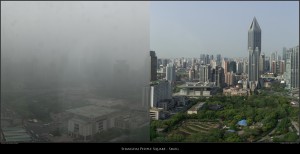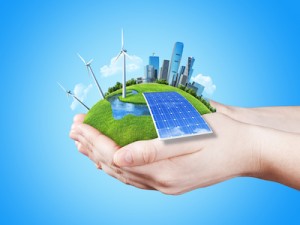with smog problem for several years and in December 2015, Chinese government triggered the first red-alert warning for smog in Beijing. ( Lowenberg, 2015) The air quality index (AQI) was over 250, more than twenty times the level recommended by the World Health Organization. Smog problem exerts tremendous influence on citizens in Beijing and the government has been making efforts to mitigate this problem. Plus, there are three things with relationships mentioned in class ought be noticed here. The industrial pollution causes smog is direct, the smog makes more industrial pollution is reverse, and Chinese government air law which relate to both of them is confounding.
Nowadays, people in China are increasingly aware of the smog problem because personal health is a priority. According to the Environmental Protection Agency (EPA), it can be dangerous to breathe in too much smog. Smog contains a health-harming pollutant called ozone. Elevated levels of ozone have been shown to cause a variety of negative health effects in the lungs such as coughing and throat or chest irritation, worsening asthma symptoms and difficulty in breathing and lung damage. Beijing is seen as a showcase city to prove China’s development to the rest of the world. However, it is notorious for air pollution in recent years.( Freeman, 2016) Industrial smog is one of the biggest components of smog in Beijing. In this essay, I will analyze three possible solutions to smog problem in Beijing and try to figure out the best one.
The first solution I want to introduce is government establishing some laws and regulations in order to reduce industrial air pollution. Industrial smog problem is an environmental issue which can not be solved by individual. It is necessary for government to introduce policies as well as enact laws. With the soaring development of economy in Beijing, hundreds of companies especially heavy industries are making money at the cost of environment. The entrepreneurs may only focus on short-term profits and ignore the environmental costs but the government should not. It is government’s duty to make laws and regulations to prevent individuals and companies from polluting the air. Some other cities have tried this method when they were in the similar smog situations and it proved to be effective. London suffered from a thick and pollutant-laden fog for four days in 1952 and approximately 4000 people were killed. The Government passed the Clean Air Acts in 1956 and 1968 which introduced a variety of measures to reduce pollution. After the Great Smog in 1952, London still struggled with smog but the air quality was improved and industrial smog problem was alleviated. Another note-worthy example is Los Angeles of 60 years ago. An economic boom and a rapid population rise, the same reasons of Beijing’s smog, made Los Angeles have the dirtiest air in the world. The federal Clean Air Act which was first launched in 1963 contributed to recovering the city’s air, although it is still one of the most polluted cities in the US, according to the America Lung Association.( Shekhtman, 2015) It can be concluded that laws and regulations are necessary and can mitigate smog problem to some degree. However, the smog problem still exists after the implementation of laws. Moreover, China already had some relative regulations such as air quality standards for coal-fired power plants but the industrial smog problem is still becoming heavier. Li Shuo, senior climate and energy policy officer at Greenpeace East Asia, said: “ China’s environmental laws have historically served more as political statements than as a tool to effectively utilize in addressing issues.”(Li, 2015)
The second solution is relocating industry. Beijing is not the only big city that struggles with air pollution because of the soar of economy. As the economy of a big city is developing, there must be a wide range of polluting industries including manufactures and petrochemistry to boost economy. When the big cities notice that their environments are too bad to keep supporting high-polluting industries, they will probably relocate those industries to surrounding areas. In this way, the industrial smog problem in big cities will be alleviated. It seems that this is the most efficient solution and Mexico City used this method in1992 when the air quality was extremely terrible. Given the air quality record in 2012 which shows 248 “good” air days (in 1992 there were only 8 “good”), Mexico City has solved its smog problem properly. However, relocating industry was only one of several methods to reduce air pollution. Mexico City also tried to kick clunkers off the capital’s streets, encourage cleaner technologies, and expand public transit and cycling options.( Shekhtman, 2015) Beijing has tried this measure in recent years by relocating high-polluting industries to its already smog-hit neighbor Hebei but the result was not satisfying. People in Beijing still can hardly see blue skies at present and Hebei province now has seven of China’s 10 smoggiest cities.( Stanway, 2015)
The third solution is using cleaner energy and encouraging cleaner technologies. China’s industrial revolution is coal-powered and has been on a striking scale and speed, resulting in serious environmental implications especially the industrial smog. Nowadays, China still relies heavily on coal but the smog problem draws increasing attention. ( Sudworth, 2015) Cleaner energy including nuclear, solar power, natural gas and hydro power will not exert negative influence on environment so if Beijing can use more clean energy than depending on coal, the air quality will likely be improved. Cleaner technologies such as developing carbon capture and sequestration technologies for coal and renewable energy technologies should also be taken into consideration. Beijing can learn from similar experiences of other cities. As mentioned before, Mexico City encouraged cleaner technologies in 1992 as one of a variety of methods to combat smog.( Lowenberg, 2015) New York is another successful example in fighting smog. In order to reduce air pollution, New York uses not only less, but cleaner sources of energy to generate electricity for its more than 8 million residents, including natural gas, nuclear, and hydroelectric.( Shekhtman, 2015) Beijing has already carried out this measure in small range and met mixed success: downtown Beijing no longer uses coal to heat homes. However, there is still small-scale coal burning in the peripheral areas – often using lower-quality coal that causes worse pollution.( Freeman, 2016) The weakness of this solution is that it will take a long time and cost a huge amount of money. Because the technology level of Beijing still need improving, it can be extremely costly to use clean energy on a large scale and encouraging cleaner technologies also require time and fund. We can not expect an instant change in this solution.
I support the third solution because I believe it can solve the problem at root and it is beneficial to sustainable development of the city despite time and capital are required. Coal is dirty and non-renewable and burning coal is the biggest component of Beijing’s pollution. According to estimates by Greenpeace, coal consumption accounts for up to half of China’s PM2.5.( Freeman, 2016) We should find a way to become less dependent on coal and cleaner energy along with cleaner technologies is the best choice. Given the severe smog situation in Beijing, it is high time that we should pay attention to making use of cleaner energy and developing cleaner technologies. Chinese government also tried to make long-term improvement. In Beijing in mid-October 2013 the government announced that 5 billion RMB will be allocated to curb air pollution. ( Ewert, 2013) and Beijing will allocate 760 billion yuan (about 124.64 billion dollars) to improve the city’s air quality by 2017.( McKirdy, 2014) We can see from the data that government is allocating more money to solve smog problem in Beijing. With enough time and fund, using cleaner energy and encouraging cleaner technologies can eventually be achieved and the people in Beijing will no longer suffer from industrial smog.
In conclusion, I introduced three solutions to industrial smog in Beijing. First is government establishing some laws and regulations. Government is essential in combating air pollution and laws and regulations are indispensable. However, this measure usually proved to be not efficient in many cases. The second one is relocating industry. It seems that this method can exert instant effect but it just solves local problem and the price of this solution is worsening air pollution in other areas. The third solution which I support is using cleaner energy and encouraging cleaner technologies. Although it may take time and money, it can solve this problem thoroughly and it is the best choice for long term development of the city.
Work cited
1.Lowenberg, O. S. (2015, December 21). Beijing’s red smog alert: How other cities dealt with air quality disasters. Christian Science Monitor. p. N.PAG.
2.Shekhtman, L. S. (2015, December 8). Beijing smog: What makes some cities cleaner than others? Christian Science Monitor. p. N.PAG.
3.Ewert, J. M. ( 2013, October 29) . From smog to blue sky? China’ s latest plan to combat air pollution. Retrieved from: http://www.eu-asiacentre.eu
4.McKirdy, E. ( 2014, February 25). China looks for blue-sky solutions as smog worsens. Retrieved from: www.cnn.com
5.Yu, K. (2016, January 5). Red alert, life inside the Beijing smog. Retrieved from: http://www.aljazeera.com
6.Freeman, J. (2016, January 4). Why is the pollution so bad in Beijing. Retrieved from: http://priceonomics.com
7.Li, S. 2015, Will China’s New Air Laws Solve its Pollution Crisis? Retrieved from:https://www.newsecuritybeat.org
8.Stanway, D. 2015, China capital to move more polluting industry to heavily polluted Hebei, retrieved from: http://www.reuters.com
9.Sudworth, J. 2015, China eyes fundamental shift in energy policy, retrieved from: http://www.bbc.com
picture source:
https://www.bing.com/images/search?q=smog+inchina&view=detailv2&&id=E61F55D58791074AA33B8886C7A42759C0AC6D75&selectedIndex=22&ccid=9b4vm0HZ&simid=608051973109058660&thid=OIP.Mf5be2f9b41d91f91abd8a2a706876119o0&ajaxhist=0
https://www.bing.com/images/search?q=smog+inchina&view=detailv2&&id=717E90780B362546C7E4A61585A28FD410B10D9D&selectedIndex=173&ccid=CakbwFWB&simid=607986350313242805&thid=OIP.M09a91bc055810be3bf4012f8ac596b8bo0&ajaxhist=0
https://www.bing.com/images/search?q=clean+energy&view=detailv2&&id=7C0D113355CA06AA89423D4837378FEEE276EEE3&selectedIndex=186&ccid=Rksj7aM1&simid=608033994384998871&thid=OIP.M464b23eda33534fa1481c70117179754o0&ajaxhist=0



